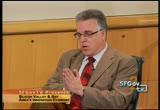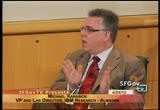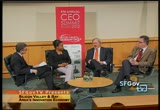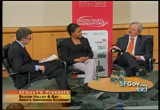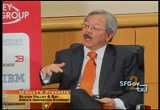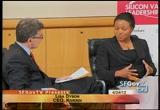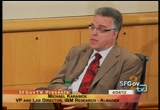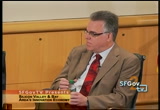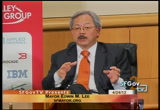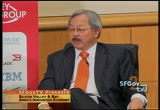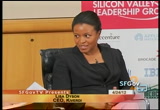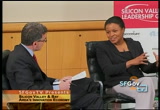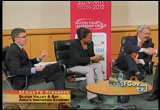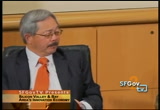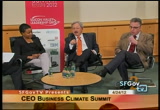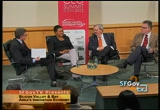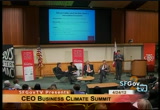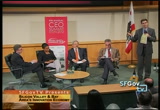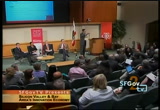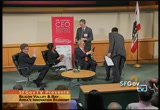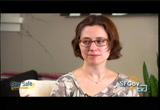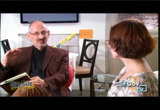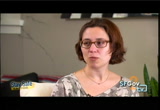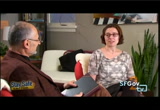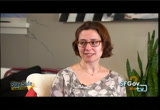tv [untitled] January 21, 2013 11:30pm-12:00am PST
11:30 pm
remember, this was 1955. we reinvented ourselves. ibm made the first product with cheese slices. we cannot do that anymore. [laughter] this place also reinvents itself in a continual basis. in that sense, we feel very much at home here. the ability to reinvent, the ability to have a real sense of where things are going is also something we see in the bay area. strategic view. one of the things that i learned we do not talk about as much in the bay area is this amazing mentoring culture. we see folks like lisa who are young, dynamic maniacs -- i think -- but there is this a
11:31 pm
very active, quiet, kind of a grey-haired mentoring culture that helped people do what they do. i do not see that anywhere else. people give up their time, give of themselves. it is just a spectacular way to foster innovation. >> i want to talk about innovation in the bay area for a moment. this is for all of you, but i will start with you, mayor lee. how would you describe the state of innovation in the bay area right now? are you concerned -- instagram comes to mind -- about a bubble? >> we have been trying to analyze that question with financial people and people in the industry. i do think there is more maturity with the companies. i get a chance to go out and
11:32 pm
talk to one new company week, when i get out of my city hall prison to meet the innovators. they introduced me to their employees. i get to have a direct dialogue with the employees and ask them what they need to stay. they say they really like being in our city because of the night life, the culture. they want education, they want a better transit system. they always have ideas to improve the municipal transit system. but when the talk about the bay area, including silicon valley, it is the same thing. transportation symptom -- systems, central subway, high- speed rail. clearly, bart to san jose has been incredibly important to everyone, so that people could travel. i think there is a lot more maturity. there are many successful company that have already turned a corner on making a profit.
11:33 pm
start-ups have long-term views. they are not looking for instant gratification, as i believe the attitude was in the late 1990's, 2000's. people are talking a lot about issues on stability and asking government, like ours, to be with them in the long term, and to create relationships. certainly, for capital investors, it really is that relationship building. they want that face-to-face time with investors around our city. so we are creating conditions for that to happen. they are not short-term leases, these are long-term leases. twitter signed in for a good 10 years. others have signed long-term leases as well. they are in it for the long haul. i think they are measuring their success, building it up on that. not only innovating and starting up, we want them to stay and
11:34 pm
grow. we have been creating those conditions for that conversation to happen. >> michael connolly said, anything to add to that? is this the right time in the valley? is there a bubble? >> i would like to speak about the clean technology sector. there was a little bit of a bubble that emerged in 2005, 2006, 2007 time frame. what has happened since then is you see the landscape changed. there have been a lot of companies and vc's, founders, that are focused on very few investments in companies but are in it for the long run. the time and invested it takes to build a clean tech company. the difference with clean tech, there might be large facilities required, investment to build your first plant, for instance. we are seeing a change in the landscape. one thing i want to add, too,
11:35 pm
for clean tech, there are organizations like the clean tech opened that foster innovation and identify and help on to produce with that system, present their idea, put together their business plan, attract the mentors and advisers to help them build their technology. the incubators are contributing to a maturing clean tech and biotech sector -- sector. >> just a short comment. we focus in this building, a research center, on technology. some of it is near term, some of it is very long term. i am glad to hear what we suggest said. i worry personally that we do not see as many long term investments as we used to. >> how do you define a long-term investment? >> good question.
11:36 pm
so, i think the question is, how speculative is this? i will use us as an example. we have a team in this building working on lithium batteries. their goal is to build a battery with 500 miles of range, for obvious reasons. we hope they will have a prototype in the feet next few years. we think -- in the next few years. we think the stars are lined up. that is a long-term investment. >> next question to all of you. michael, we will start with you. we know government is the regional -- at the regional, state, and local level can help or hinder startup companies. what would you like to see from
11:37 pm
the governments here in the valley, sacramento, or in d.c., that would strengthen the innovation economy? >> i could go on about immigration and corporate tax policy reform, but i am a researcher, so i will not. >> and we have seven minutes. >> mayor lee said it perfectly. the fundamental thing that companies are looking for is to be engaged in the process. we use a term in computing called agile. we look for more ability and the possibility to work with us, iterate in the process, rather than what we often see as we call the waterfall, take-it-or- leave-it. flexibility and agility is what is most important. >> mayor lee? >> i have always thought of our city as being the gateway to the rest of the world. i have often talked, with
11:38 pm
companies, i want to be with you when you turn the corner. we want to be the city that treats international markets for your products. i do not know if you know this but we have 70 counsel general offices in san francisco, the highest number outside of washington, d.c. we want to make sure that our companies know we are not just in it for san francisco, the region. we have to tap international markets. they love hearing that. some of the companies already know that they have game players in china and japan, but also, clout computing, all the technology breakthroughs have international capacity. i think that is why we need a regional approach. that is why i am here, to make sure we protect our hetch hetchy water system. that creates the standard of
11:39 pm
living that we want, that keeps people here. that is why we have regional transport systems. whatever companies do not come here could end up going to europe or japan or china. we want them to maybe have their headquarters here in the bay area. >> is there one regional issue that elected officials across the region could focus on? if we are back here 12 months from now, i am able to ask you the question -- here is what you said 12 months ago and here is where we are now. is there one thing? >> i think it will be transportation. we have to make that infrastructure investment. we have to get our federal and state government more aligned. i know jerry is a big fan of our high speed rail, but we have to turn the corner on that. for us, in san francisco, a third of our flights out of sfo is to los angeles. we cannot have the capacity for
11:40 pm
international flights. the whole secret behind international success is having those flights coming in. unless we move that l.a. commute over to high-speed rail, which is an excellent thing, we will not be able to treat the capacity we need because we cannot expand the airport. >> last word to you, lisa. >> i will sit a couple of things slightly differently. one of the core things that started to do is they develop lot of ip. when getting our patents filed, approved, it is a very long run up process. if there could be emphasis on accelerated patenting process is, that would be beneficial. maybe even having a patenting office here in the silicon valley. i know there are some that have pushed for that in the past. the other thing i will add about
11:41 pm
funding and investing, the different initiatives that governments have, grants and are given to -- that are given to foster and push innovation is something that is done very well in the university setting. i think further investing in companies that take the research at the commercialization phase is something that we have benefited from and would love for that to continue. >> the last question for the panel is to you, lisa. say, this is a room of potential funders. what is your elevator pitch? [laughter] >> absolutely, great. we are addressing two issues. on the one hand, there is an ever-increasing amount of waste that is generated. as the drift toward 9 billion people in 2014, we are generating waste in landfills,
11:42 pm
manufacturing waste, agricultural residue, etc. is there a wayon the other handa court feedstock with almost everything we use, whether it is plastics, detergents, obviously fuel. how can we address a sustainable source of oil? we have bridged the gap. we have developed an innovative technology. a two-step process that taste -- takes a variety of ways to carbon resources and converts them into oil through a biological process. we do it at a lower cost and sustainably, and it has a benefit for not only industry but the planet. >> i will go get my checkbook. a round of applause for our panel. [applause] according to carl, we have five more minutes. so you get to clap again in five more minutes. [laughter]
11:43 pm
you have all talked a little bit about the culture here. how important is it that the environment here succeeds in continuing to draw people and draw talent and investment? the example we heard in your introduction was you went to school add mit. you came here to start your business. there is another guy on facebook who has said if he had it all to do over again, he would have stayed in boston. how important is that culture and environment? >> it is critical. it is critical to have minds that have been educated, interdisciplinary people coming to the table, different perspectives, that energy and enthusiasm around thinking differently, and around paradigm shifts, around developing
11:44 pm
breakthrough technologies, and to be able to attract those people to this area is crucial. i think that that is something that has been a benefit of being here, that a lot of people are attracted to silicon valley. that is crucial to any company starting in taking their technology to the next level. >> can you talk about the incubator? >> yes. >> the qb3? >> yes, mission bay, everybody knows. uc san francisco has conduct encourage it with research. some of the larger companies that research labs in mission bay as well. bayer and others. they are even innovating about their laboratories, because it is so expensive to build your own laboratory. so they are trying to bring some of these pharmaceutical answers to the market faster. they have an incredible spirit of innovation in those laboratories. and they are inviting other companies, not just from the bay
11:45 pm
area air even our country, they're inviting international. we had our first canadian incubator that was established just a couple months ago. they are excited to be kind of cross-referencing their research and ideas. >> why are they coming here? >> they are coming here because there is really ongoing levels of conversation and sharing of experiences that are part of, kind of, thinking outside of the box and thinking in different ways, turning things upside down, hacking your way through some of these ideas and not being afraid. and trying to find applicability for them. that is the spirit of the valley, the spirit of san francisco. we have always been edgy when it comes to openness. we're taking advantage of that. we want to embrace different cultures to impact that as well. what people see here might be different from how they see it
11:46 pm
in india and some of the other countries that are emerging here, trying to apply it in ways which would have a great benefit, or just thinking very differently about it. i think the spirit of innovation is an attractive thing for talent. obviously, education is behind it as well. there's a lot of confidence about being able to risk in being a little more risk-taking. that is part of, kind of, my leadership. i did not apply to be the mayor of san francisco. i took that risk with a very good knowledge that -- sure, i may not be a supreme politician, but i wanted to build a different relationships with people. we have done that. we have invited a lot more different kinds of talent to come in and use that free spirit in innovating. >> michael, last word. >> yes, knowledge gets created with the people who think about the problems. and what must be sustained here
11:47 pm
is that focus on getting feet into the problem. with understanding the problems comes the ideas. this is an idea-generating place. like no other. i spent three years living in beijing, and i watched what they are trying to do over there. fundamentally different. here, it is inherently and opened, bottom-up idea meritocracy. it is a good way for this place to be. >> i want to follow up on that. because there are so many other places in the world that want to replicate what we have here. is that possible? >> what is the appropriate answer? anything is possible. i think there is a bunch of things that come together here. education is a big part of it. as much as we have talked about the challenges we have in
11:48 pm
educating our youth, it is still the case that education here is as much about the journey as about the end result. my personal belief is that as long as we keep that focus on the inquiry as opposed to the yes/no result, we will do fine. when you look at other parts in the world, my view is you can gauge how innovative a populace you're going to generate by the way they educate their people. >> you know, i would say that he has a great point there. i think it in fights collaborative approaches to problem-solving as well -- it invites a calendar to the approaches to problem-solving. we are having a great conversation in san francisco about this shared economy, a
11:49 pm
collaborative thing. it began to me by car-sharing. i was a big fan of car-sharing and the electric vehicles to see if we could get less emissions. now we're looking at companies, including smaller innovative companies, looking at shared space and how to complement our environmental goals here with new economies that are merging out. i think that is challenging the way our tax structure has been and the way we look at certain industries, but inviting a collaborative spirit of new ideas that would create literally new jobs and new economies. it is exciting. when you allow collaborative approaches to be focused on. >> i promised the last word on the panel. >> great. the one thing i will add to that is that, speaking to michael's point earlier, one thing you have here, a lot of people who have done it, that started companies. they succeeded, failed,
11:50 pm
succeeded. they had invested. they have done all of the things that we at start-ups are trying to do and are navigating through. having both those that are being educated coming up with the bright ideas and the desire to start something new in those who have done it, it creates a great a the system. >> now a round of applause for our panel. [applause] >> panelists, what an outstanding discussion on regional innovation. james, as always, it is a delight to partner with you. lisa said one thing we have here is a lot of people who have done it. michael said ibm's first product was a cheese slicer. we do not make those anymore. we keep in a bidding. and mayor lee, start-ups at long-term views. they're not looking for instant gratification.
11:51 pm
the key is long-term innovation with networking. it makes this region unique, doesn't it? i hope you enjoyed this panel as much as i did. i want to shine the spotlight just another moment on lisa dyson. you heard a little bit about her background. i hope you will bing or google her, whatever your preferences, and learn more about our company. the silicon valley leadership group did a soft launch in january of something we call start-up silicon valley. it is for innovation economy, ceo's in this region to join at the leadership group basically for free. because we want to capture in the them to the dna that david packard, our founder had, which was a balance of running, brilliance, dynamic companies while, at the same time, being deeply engaged in your communities and in the quality
11:52 pm
of life of your employees. that is the scale that we want to raise up in these incredibly innovative young entrepreneurs. we have about 20 of them here in the audience today. i want to just mention three of them and embarrass them. they do not know i am going to do this. all of these at this in common. they have less than 40 employees currently. their business has been around for less than four years. and, like me, they are younger than 40 years old. [laughter] why are you laughing? [laughter] let me introduce the ceo of snoozie. stand. [applause] the ceo of good joe. [applause] and the ceo of sylvantex. [applause]
11:53 pm
a lot of these start-ups doing incredible innovation. some will succeed. others will not. these people, however, will succeed no matter what they do. and that is why we're so excited about this new initiative. we want you to mentor and get to know and meet them. with that, we're going to go ahead and thank this panel a final time with -- again, we do not whine in silicon valley, but we do enjoy fine wine -- w-i-n- e. we have a wonderful pinot noir for each of our three panelists. >> thank you. [applause]
11:54 pm
>> hi. i am cory with san francisco and we're doing stay safe and we're going to talk about what shelter in place or safe enough to stay in your home means. we're here at the urban center on mission street in san francisco and joined by carla, the deputy director of spur and one of the persons who pushed this shelter in place and safe enough to stay concept and we want to talk about what it
11:55 pm
means and why it's important to san francisco. >> as you know the bay area as 63% chance of having a major earthquake and it's serious and going to impact a lot of people and particularly people in san francisco because we live on a major fault so what does this mean for us? part of what it means is that potentially 25% of san francisco's building stock will be uninhibit tabl and people can't stay in their homes after an earthquake. they may have to go to shelters or leave entirely and we don't want that to happen. >> we want a building stock to encourage them to stay in the homes and encourage them to stay and not relocate to other locations and shelters.
11:56 pm
>> that's right so that means the housing needs to be safe enough to stay and we have been focused in trying to define what that means and you as a former building official knows better than anybody the code says if an earthquake happens it won't kill you but doesn't necessarily say that can you stay in your home and we set out to define what that might mean and you know because you built this house we're in now and this shows what it's like to be in a place safe enough to stay. it's not going to be perfect. there maybe cracks in the walls and not have gas or electricity within a while but can you essentially camp out within your unit. what's it going to take to get the housing stock up to this standard? we spent time talking about this and one of the building types we talk about
11:57 pm
was soft story buildings and the ground floor is vulnerable because there are openings for garages or windows and during the earthquake we saw in the marina they went right over and those are -- >> very vulnerable buildings. >> very and there are a lot of apartment buildings in san that that are like that. >> and time to. >> >> retrofit the buildings so people can stay in them after the earthquake. >> what do they need? do they need information? do they need incentives? mandates? >> that's a good question. i think it starts with information. people think that new buildings are earthquake proof and don't understand the
11:58 pm
performance the building will have so we want a transparent of letting people know is my building going to be safe in it after an earthquake? is my building so dangers i should be afraid of being injured? so developing a ranking system for buildings would be very important and i think for some of the larger apartment buildings that are soft story we need a mandatory program to fix the buildings, not over night and not without financial help or incentive, but a phased program over time that is reasonable so we can fix those buildings, and for the smaller soft story buildings and especially in san francisco and the houses over garages we need information and incentives and coaxing the people along and each of the owners want their house to be safe enough. >> we want the system and not
11:59 pm
just mandate everybody. >> that's right. >> i hear about people talking about this concept of resiliency. as you're fixing your knowledge you're adding to the city wide resiliency. >> >> what does that mean? >> that's a great question. what spur has done is look at that in terms of recovery and in new orleans with katrina and lost many of the people, hasn't recovered the building stock. it's not a good situation. i think we can agree and in san we want to rebuild well and quickly after a major disaster so we have defined what that means for our life lines. how do we need the gasolines to perform and water perform after an earthquake and the building
50 Views
IN COLLECTIONS
SFGTV2: San Francisco Government Television Television Archive
Television Archive  Television Archive News Search Service
Television Archive News Search Service 
Uploaded by TV Archive on

 Live Music Archive
Live Music Archive Librivox Free Audio
Librivox Free Audio Metropolitan Museum
Metropolitan Museum Cleveland Museum of Art
Cleveland Museum of Art Internet Arcade
Internet Arcade Console Living Room
Console Living Room Books to Borrow
Books to Borrow Open Library
Open Library TV News
TV News Understanding 9/11
Understanding 9/11